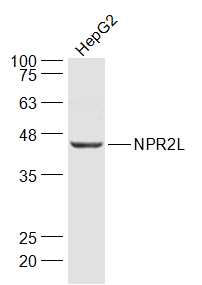产品货号 : mlR6079
英文名称 : G21 protein/NPR2L
中文名称 : G21蛋白质抗体
别 名 : G21 protein; Gene 21 protein; Homologous to yeast nitrogen permease (candidate tumor suppressor); Homologous to yeast nitrogen permease; NPR 2L; NPR L2; NPR like 2; NPR2 like; NPRL 2; NPRL2; Tumor suppressor candidate 4; TUSC 4; TUSC 4 protein; TUSC4; TUSC4 protein; NPRL2_HUMAN.
研究领域 : 肿瘤 细胞生物 染色质和核信号 信号转导 表观遗传学
抗体来源 : Rabbit
克隆类型 : Polyclonal
交叉反应 : Human, Mouse, Rat, Pig, Cow, Horse, Rabbit,
产品应用 : WB=1:500-2000 ELISA=1:500-1000 IHC-P=1:400-800 IHC-F=1:400-800 IF=1:100-500 (石蜡切片需做抗原修复)
not yet tested in other applications.
optimal dilutions/concentrations should be determined by the end user.
分 子 量 : 44kDa
细胞定位 : 细胞浆 细胞膜
性 状 : Lyophilized or Liquid
浓 度 : 1mg/ml
免 疫 原 : KLH conjugated synthetic peptide derived from human NPR2L:221-320/380
亚 型 : IgG
纯化方法 : affinity purified by Protein A
储 存 液 : 0.01M TBS(pH7.4) with 1% BSA, 0.03% Proclin300 and 50% Glycerol.
保存条件 : Store at -20 °C for one year. Avoid repeated freeze/thaw cycles. The lyophilized antibody is stable at room temperature for at least one month and for greater than a year when kept at -20°C. When reconstituted in sterile pH 7.4 0.01M PBS or diluent of antibody the antibody is stable for at least two weeks at 2-4 °C.
PubMed : PubMed
产品介绍 : NPR2L is homologous to yeast nitrogen permease and is a candidate tumor suppressor, being a negative regulator of cell cycle. Most abundant in skeletal muscle, followed by brain, liver, and pancreas, with lower amounts in lung, kidney, placenta, and heart. Expressed in most lung cancer cell lines tested. There are two isoforms, produced by alternative splicing.
Function:
Suppresses Src-dependent tyrosine phosphorylation and activation of PDPK1 and its downstream signaling. Down-regulates PDPK1 kinase activity by interfering with tyrosine phosphorylation at the Tyr-9 Tyr-373 and Tyr-376 residues. May act as a tumor suppressor. Suppresses cell growth and enhanced sensitivity to various anticancer drugs.
Subunit:
Forms a heterodimer with NPRL3. Interacts with PDPK1.
Tissue Specificity:
Most abundant in skeletal muscle, followed by brain, liver and pancreas, with lower amounts in lung, kidney, placenta and heart. Expressed in most lung cancer cell lines tested.
Similarity:
Belongs to the NPR2 family.
SWISS:
Q8WTW4
Gene ID:
10641
Important Note:
This product as supplied is intended for research use only, not for use in human, therapeutic or diagnostic applications.
产品图片












